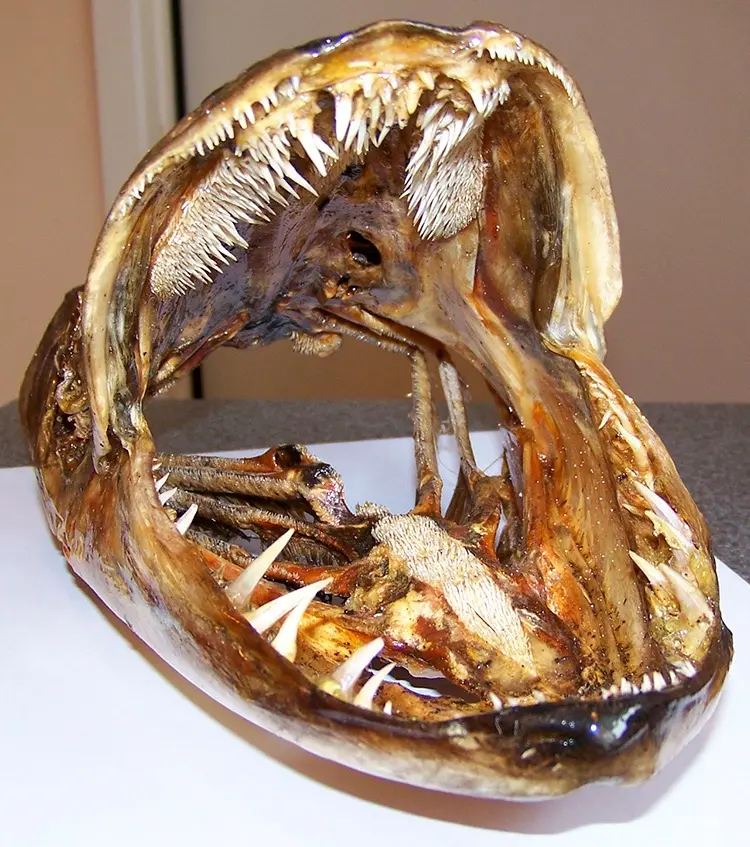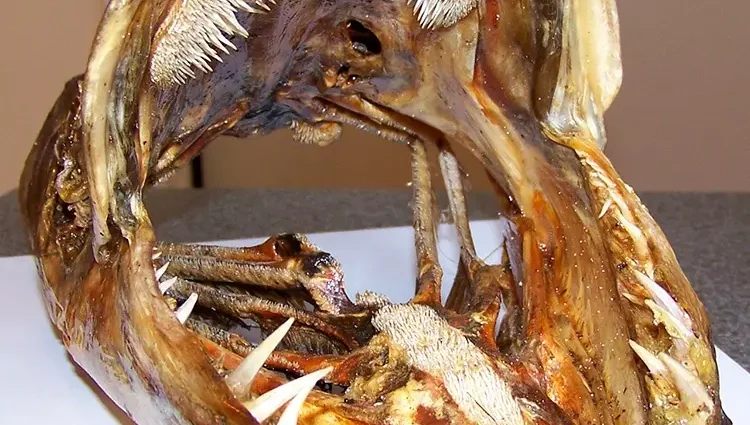The teeth (fangs) of the pike are white, shiny, sharp and strong. The base of the teeth is hollow (tube), surrounded by a solid mass, the color and structure of which is somewhat different from the teeth – this mass connects the tooth to the jaw very firmly.
In addition to fangs, there are three “brushes” of small and very sharp teeth in the pike’s mouth. Their tips are somewhat curved. The brushes are located on the upper jaw (along the palate), they are built in such a way that when stroking them with fingers towards the pharynx, the teeth fit (bend), and when stroking in the direction from the pharynx, they rise and stick into the fingers with their points. Another small brush of very small and sharp teeth is located on the predator’s tongue.
The teeth of the pike are not a chewing apparatus, but serve only to hold the prey, which it turns over with its head to the throat and swallows whole. With its fangs and brushes, with powerful jaws, the pike easily tears (rather than bites) a soft leash or fishing tackle cord.
The pike has an amazing ability to change its teeth-fangs of the lower jaw.
How do pike change teeth
The question of the change of teeth in pike and the influence of this process on the success of fishing has long been of interest to amateur fishermen. Many anglers attribute unsuccessful pike hunting to the absence of pike biting due to the periodic change of teeth in it, which lasts one to two weeks. During this, she allegedly does not eat, as she cannot grab and hold prey. Only after the pike’s teeth grow back and get stronger, it begins to take and catch well.
Let’s try to answer the questions:
- How does the process of changing teeth in a pike proceed?
- Is it true that during the change of teeth, the pike does not feed, and therefore there is not enough bait?
In the textbooks of ichthyology, fishing and sports literature, there is no reliable information on these issues, and the statements that are encountered are not supported by any substantiated data.

Usually the authors refer to the stories of fishermen or most often to the book by L.P. Sabaneev “Fish of Russia”. This book says: Large prey has time to escape from the mouth of a predator when it has a change of teeth: the old ones fall off and are replaced by new, still soft ones … At this time, pikes, catching relatively large fish, often only spoil it, but they cannot hold it because of the weakness of their teeth. maybe, why the nozzle on the vents is often then only crumpled and not even bitten to the point of blood, which is well known to every fisherman. Sabaneev says further that the pike changes its teeth not once a year, namely in May, but every month at the new moon: at this time, its teeth begin to stagger, often crumble and deprive it of the possibility of an attack.
It should be noted that the observation of the change of teeth in pike is very difficult, especially the observation of small teeth standing on the front of the lower and upper jaws. It is even more difficult to establish the change of small teeth of the palate and teeth on the tongue. Relatively free observation is available only to the fang-shaped teeth of the pike, standing on the sides of the lower jaw.
Observations suggest that the change of teeth in the lower jaw of a pike occurs as follows: a tooth (fang), which has stood the due date, having become dull and yellow, dies, lags behind the jaw, is disconnected from the tissue surrounding it and falls out. In its place or next to it, one of the new teeth appears.
New teeth are strengthened in a new place, emerging from under the tissue located on the jaw, on its inner side. The emerging tooth first assumes an arbitrary position, bending its tip (apex) most often inside the oral cavity.
A new tooth is held on the jaw only by compressing it with a tubercle of the surrounding tissue, as a result of which, when pressed with a finger, it freely deviates in any direction. Then the tooth is gradually strengthened, a small layer (similar to cartilage) is formed between it and the jaw. When pressing on the tooth, some resistance is already felt: the tooth, slightly pressed to the side, takes its original position if the pressure is stopped. After a certain period of time, the base of the tooth thickens, being covered with an additional mass (similar to bone), which, growing on the base of the tooth and under it, tightly and firmly connects it to the jaw. After that, the tooth no longer deviates when pressed to the side.
The teeth of a pike do not change all at once: some of them fall out, some remain in place until the newly erupted teeth are firmly fixed on the jaw. The process of changing teeth is continuous. The continuity of the change of teeth is confirmed by the presence in the pike of a large supply of fully formed teeth (canines) lying under the tissue on both sides of the lower jaw.
The observations made allow us to answer the following questions:
- The process of changing teeth in a pike proceeds continuously, and not periodically and not during a new moon, as indicated in the book “Fish of Russia”.
- The pike, of course, also feeds during the change of teeth, so no breaks in catching it should be done.
The absence of a bite and, consequently, unsuccessful pike fishing, apparently, are due to other reasons, in particular, the state of the water horizon and its temperature, an unsuccessfully chosen fishing spot, unsuitable bait, complete saturation of the pike after increased zhor, etc.
It has not yet been possible to find out whether all the teeth of the pike or only the fangs of the lower jaw are replaced and what causes the change of teeth in the pike.










